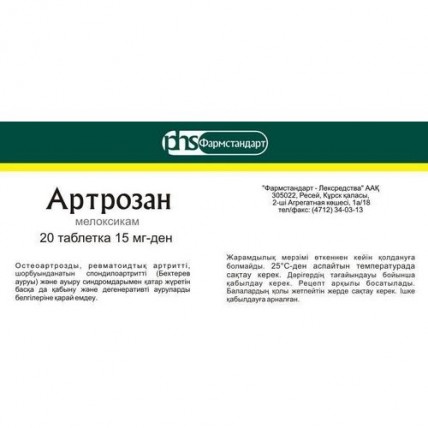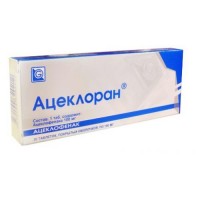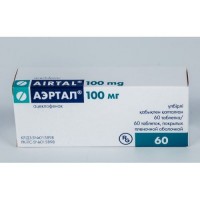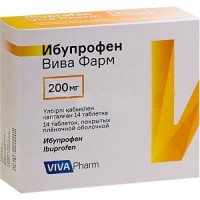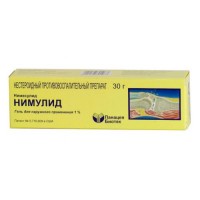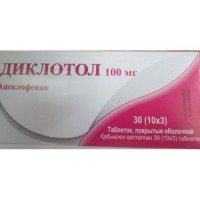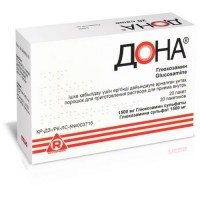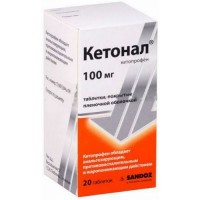Artrozan 15 mg (20 tablets)
- $18.00
The instruction for medical use of ART ROSE TREE medicine the Trade name Artrozan Mezhdunarodnoye the unlicensed name Meloksikam Lekarstvennaya a form of the Tablet of 15 mg Structure One tablet contains active agent - to meloksika – 15 mg, excipients: potato starch, lactoses monohydrate, polyvinylpirrolidone middlemolecular medical (povidone), trisodium citrate, magnesium stearate, aerosil (silicon dioxide colloidal). The description of the Tablet from light yellow till yellow color of a ploskotsilindrichesky form with a facet and risky. Insignificant marbling is allowed. Pharmacotherapeutic group Non-steroidal anti-inflammatory drugs. Oksikama. The code of automatic telephone exchange M01AC06 the Pharmacological Pharmacokinetics Well properties is soaked up from digestive tract, absolute bioavailability of a meloksikam – 89%. The concomitant use of food does not change absorption. When using drug inside in a dose of 15 mg its concentration is proportional to a dose. Equilibrium concentration are reached within 3-5 days. At prolonged use of drug (more than 1 year), concentration are similar to those which are noted after the first achievement of a steady condition of pharmacokinetics. Linking with proteins of blood plasma makes 99%. Range of differences between the maximum and basal concentration of drug after its reception is rather small once a day and is 0.8 - 2.0 mkg/ml (Cmin and Cmax values are given, respectively). Meloksikam gets through gistogematichesky barriers, concentration in synovial fluid reaches 50% of the maximum concentration of drug in plasma. Almost it is completely metabolized in a liver with formation of four inactive derivatives in the pharmacological relation. The main metabolite 5, - to karboksimeloksika (60% of dose size), is formed by oxidation of an intermediate metabolite, 5, - a hydroksimetilmeloksikam who is also excreted, but to a lesser extent (9% of dose size). The researches in vitro showed that in this metabolic transformation an important role is played by CYP 2C9, the additional value has an isoenzyme of CYP 3A4. Peroxidase which activity probably individually valyirut takes part in formation of two other metabolites (making, respectively, 16% and 4% of drug dose size). It is removed equally with a stake and urine, mainly in the form of metabolites. With a stake in an invariable look less than 5% of the size of a daily dose are removed, in urine in an invariable look drug is found only in trace quantities. Elimination half-life (T1/2) of a meloksikam makes 15-20 hours. The plasma clearance averages 8 ml/min. At elderly people the clearance of drug decreases. Distribution volume low, also averages 11 l. The liver or renal failure of moderate severity essentially does not render significant effect on pharmacokinetics of a meloksikam. Artrozan's pharmacodynamics – the non-steroidal anti-inflammatory drug possessing anesthetic, febrifugal and analgetic action. Anti-inflammatory action is connected with braking of enzymatic activity of cyclooxygenase-2 (TsOG-2) participating in biosynthesis of prostaglandins in the field of inflammation. To a lesser extent to meloksika affects cyclooxygenase-1 (TsOG-1) participating in synthesis of the prostaglandin which is protecting a mucous membrane of digestive tract and taking part in regulation of a blood-groove in kidneys. Indications - symptomatic treatment of an osteoarthrosis - a pseudorheumatism - an ankylosing spondylarthritis (Bekhterev's disease) both the other inflammatory and degenerative diseases which are followed by a pain syndrome. The route of administration and doses take the Drug inside at meal time once a day. Artrozan can appoint only to adults or teenagers 15 years are more senior. Osteoarthrosis: 7.5 mg a day, if necessary a dose can be increased to 15 mg. - at rheumatoid arthritis: 15 mg a day. After achievement of therapeutic effect the dose can be reduced to 7.5 mg a day. - in an osteoarthrosis: 7.5 mg a day. At inefficiency the dose can be increased up to 15 mg a day. - in an ankylosing spondylarthritis: 15 mg a day. The maximum daily dose should not exceed 15 mg. At patients with the increased risk of development of side effects and also at the patients with the profound renal failure who are on a hemodialysis, the dose should not exceed 7.5 mg a day. Duration of treatment is appointed by the attending physician individually. Side effects - nausea, vomiting, an abdominal pain, diarrhea, a constipation, a meteorism, GIT erosive cankers, perforation of a stomach or intestines, gastrointestinal bleeding (hidden or obvious), increase in activity of hepatic enzymes, hepatitis, colitis, stomatitis, dryness of a mouth, an esophagitis - tachycardia, increase in arterial blood pressure, feeling of inflows - aggravation of a course of bronchial asthma, cough - a headache, dizziness, sonitus, a disorientation, confusion of thoughts, a sleep disorder - hypostases, interstitial nephrite, renal medullary necrosis, an uric infection, a proteinuria, a hamaturia, a renal failure - conjunctivitis, illegibility of sight - an itching, skin rash, a small tortoiseshell, a mnogoformny exudative erythema (including Stephens-Johnson's syndrome), the toxic epidermal necrolysis (Lyell's disease), the increased photosensitivity - anemia, a leukopenia, thrombocytopenia - anaphylactoid reactions (including an acute anaphylaxis), swelled lips and language, an allergic vasculitis Others: Contraindication fever - hypersensitivity to a meloksikam or to any component of drug - existence in the anamnesis of bronchial asthma, a polypose mucous a nose, conjunctivitis, the Quincke's disease or skin rashes caused by intake of acetylsalicylic acid or other NPVS - a peptic ulcer of a stomach and duodenum in an aggravation phase - gastrointestinal bleeding, cerebrovascular bleedings or other hemorrhagic diseases - inflammatory bowel diseases in an aggravation phase, Crohn's disease, nonspecific ulcer colitis - a pain syndrome after aortocoronary shunting - the profound heart failure - a heavy liver and renal failure - children's and teenage age up to 15 years - pregnancy and the period of a lactation Medicinal interaction at simultaneous use with other non-steroidal anti-inflammatory drugs (and also with acetylsalicylic acid) increases risk of developing of erosive cankers and bleedings of a GIT at simultaneous use with hypotensive drugs, decrease in efficiency of action of the last at simultaneous use with drugs of lithium possibly development of cumulation of lithium and increase in its toxic action (control of concentration of lithium in blood is recommended) at simultaneous use with a methotrexate is possible side effect of the last on the haematogenic system (danger of developing of anemia and a leukopenia, periodic control of the general blood test is shown) at simultaneous use with diuretics amplifies and with cyclosporine the risk of developing a renal failure at simultaneous use with intrauterine contraceptive means increases perhaps decrease in efficiency of action of the last at simultaneous use with anticoagulants (heparin, tiklopidin, warfarin) and also with thrombolytic drugs (streptokinase, fibrinolysin) the risk of developing bleedings (periodic control of indicators of blood clotting is necessary) at simultaneous use increases with holestiraminy, as a result of binding of a meloksikam, its removal through a GIT Combined use of NPVS and antagonists of receptors of angiotensin II amplifies (also as well as APF inhibitors) enhances effect of decrease in glomerular filtration. At patients with a renal failure it can lead ment of an acute renal failure. Drug can reduce efficiency of intrauterine contraceptives. Special instructions It is necessary to be careful at use of drug for patients who have in the anamnesis a peptic ulcer of a stomach or duodenum and also at the patients who are on anti-coagulative therapy. At such patients the risk of developing of ulcer and erosive diseases of digestive tract is increased. It is necessary to be careful and control indicators of function of kidneys at use of drug for patients of advanced age, patients with chronic heart failure with the circulatory unefficiency phenomena, at patients with cirrhosis and also at patients with a hypovolemia as a result of surgical interventions. At patients with a renal failure if the clearance of creatinine more than 25 ml/min. is not required to correction of the mode of dosing. At the patients who are on dialysis, the dosage of drug should not exceed 7.5 mg/days. The patients accepting at the same time diuretics and to meloksika have to accept enough liquid. If in the course of treatment there were allergic reactions (itching, skin rash, a small tortoiseshell, a photosensitization) it is necessary to see a doctor for the purpose of the solution of a question of the termination of administration of drug. Features of influence of medicine on ability to run the vehicle or potentially dangerous mechanisms Use of drug can cause emergence of undesirable effects in the form of a headache and dizziness, drowsiness. It is necessary to refuse control of vehicles and service of the machines and mechanisms demanding concentration of attention. Overdose Symptoms: consciousness disturbance, nausea, vomiting, pains in epigastriums, GIT bleeding, an acute renal failure, a liver failure, an apnoea, an asystolia. Treatment: there is no specific antidote, at overdose of drug it is necessary to carry out gastric lavage, intake of activated carbon (within the next hour), symptomatic therapy. Holestiramin accelerates removal of drug from an organism. The artificial diuresis, urine alkalinization, a hemodialysis – are ineffective because of high communication of drug with blood proteins. The form of release and packing On 20 tablets place in blister strip packaging. On 1 planimetric packing together with the instruction for medical use in the state and Russian languages place in a pack from cardboard. To Store storage conditions at a temperature not over 250C. To store out of children's reach! 3 years not to apply a period of storage on expiry date! Prescription status According to the prescription JSC Pharmstandard — Leksredstva Producer, 305022, Russia, Kursk, st. 2 I Modular, 1a/18. Ph. / fax: (4712) 34-03-13.
